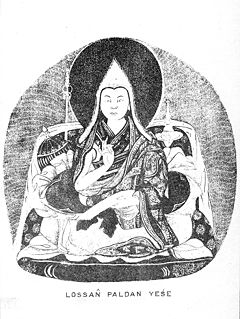Lobsang Palden Yeshe, 6th Panchen Lama



Lobsang Palden Yeshe (1738–1780) (
The Panchen Lama was distinguished by his writings and interest in the world. In 1762 he gave the
He befriended
He also had dealings with Lama
In 1778, the Qianlong Emperor invited Palden Yeshe to Beijing to celebrate his 70th birthday. He left with a huge retinue in 1780 and was greeted along the way by Chinese representatives. To mark the occasion, Qianlong ordered the construction of Xumi Fushou Temple, based on the design of Tashilhunpo Monastery, at the Chengde Mountain Resort.[5] When Palden Yeshe reached Beijing, he was showered with riches and shown the honour normally given to the Dalai Lama. However, he contracted smallpox and died in Beijing on November 2, 1780.[3][6]
Palden Yeshe's stepbrother, the 10th Shamarpa Mipam Chödrup Gyamtso, had hoped to inherit some of the riches given to his brother in Beijing after his death. When this didn't happen, he conspired with the Nepalese who sent a Gurkha army in 1788 which took control of Shigatse. The Shamarpa, however, did not keep his side of the bargain and the Gurkha army returned three years later to claim their spoils, but the Chinese sent an army to support the Tibetans and drove them back to Nepal in 1792.[6][7]
The tombs from the Fifth to the Ninth Panchen Lamas were destroyed during the
References
- ^ Khetsu Sangpo Rinpoche. (1982). "Life and times of the Eighth to Twelfth Dalai Lamas." The Tibet Journal. Vol. VII Nos. 1 & 2. Spring/Summer 1982, p. 47.
- ISBN 0-8047-0901-7(pbk)
- ^ ISBN 0-8047-0901-7(pbk)
- ISBN 1-85230-332-8.
- ISBN 9780415320061
- ^ a b Norbu, Thubten Jigme and Turnbull, Colin. 1968. Tibet: Its History, Religion and People. Reprint: Penguin Books, 1987, p. 272.
- ISBN 0-8047-0901-7
- ISBN 1-74059-523-8p. 175.

